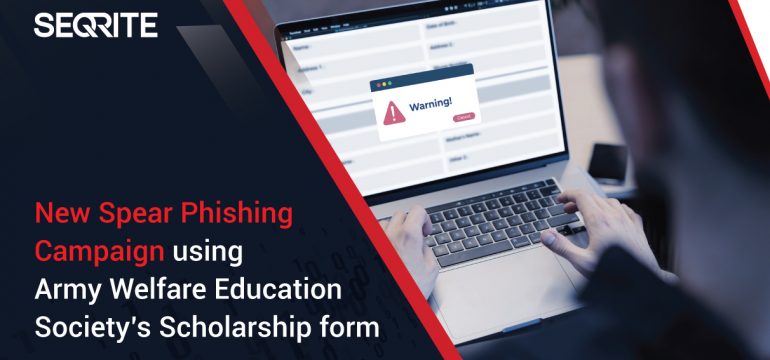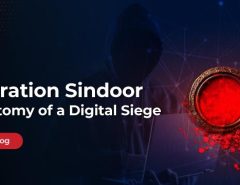Introduction:
Researchers at Quick Heal Security Labs have uncovered a potential Spear Phishing campaign targeted against Indian Army personnel. In this attack, the attackers are using “Army Welfare Education Society” Scholarship form as lure.
About AWES:
Army Welfare Education Society (AWES) manages and ensures proper education facilities to children of Indian Army personnel through Local Military Authorities. Established in 1983, the society has its office at Shankar Vihar, Delhi Cantonment and over the years has opened over 137 Army Public Schools and 249 Army Pre-Primary Schools across India.
Details about the recent attack:
Document Analysis:
“ESSA-Scholarships.docx”
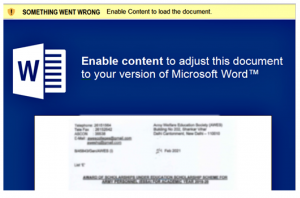
Fig.1 Template

Fig.2 ESSA-Scholarships.docx
The “ESSA-Scholarships.docx” triggers CVE-2017-0199 vulnerability which later launches the stage of “.dotm” file from landing page embedded inside “settings.xml.rels”.
This technique is popularly known as “Template Injection” as well and is popular among threat actors since the detection is trivial.
“essa.dotm”
As soon as the user disables “Protected View”, the previous stage downloads and executes “essa.dotm” which further executes the macros.
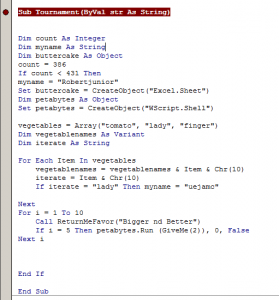
Fig.3 Extracting Data
All the data of staged payloads are stored inside “UserForum.TextBox”. The macro has four text boxes as object, containing all the data to be dropped on disc as files and initiate further stages.

Fig.4 Routine for Saving all the files
Executable Payload Analysis:
“fixit.exe”: This tends to behave as loader unless command is not issued from command and control. The payload is completely new, written in .NET and does not perform too many actions.
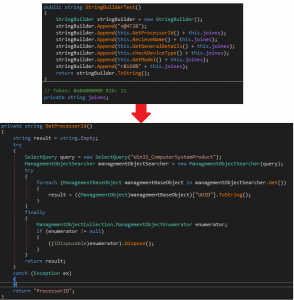
Fig.5 Information collection
The payload comes with .scr extension and once executed, it collects the following information about infected host using WMI Queries:
1; Processer ID.
2; User Name.
3; General Details (Architecture, Caption, Version).
4; Check for Device Type (Laptop/Desktop).
5; Device Model.
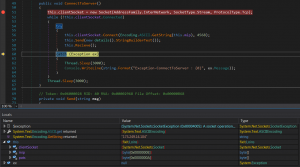
Fig.6 Initial knock being sent to C2
Once information is collected about the host, the payload sends it to C&C and performs following actions according to command issued from C&C:
1; Get Process List.
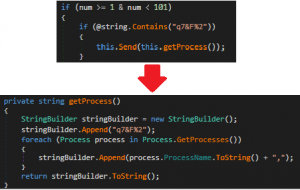
Fig.7 Sending Running Process List
If command “q7&F%2 ” is issued from C2, payload sends list of running processes by using “Process.GetProcesses()” and creates an array of list.
2; Write and Execute Files:
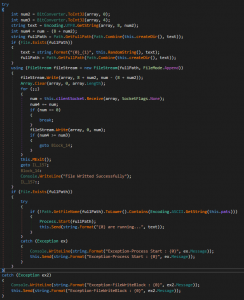
Fig.8 Write and Execute Routine
Once C2 responds back with command, the payload receives files and execute on current folder.
Persistence:
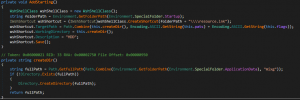
Fig.9 Creating Persistence
Payload gains persistence on infected host by writing LNK file to “Startup Folder”. It’s a well-known technique used by other threat actors. Payload loads an assembly which is publicly available called “IWshRuntimeLibrary.dll” and tries to create a LNK file in target folder giving reference to running payload’s working directory.
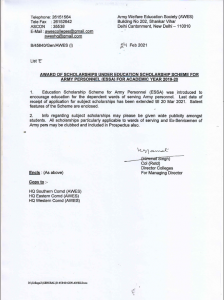
Taken from – https://www.aitpune.com/Notices/Scholarship/ESSA-Circular.pdf
Once whole chain executed successfully, the macro opens PDF file dropped in ProgramData directory, which is publicly available.
Conclusion:
If the attack is successful, attackers they may be able to exfiltrate sensitive data from the victim machine. Our further analysis and observation is still on to identify which group is behind this attack. Till then, we advise AWES to exercise caution and inform all their members about this attack.
MITRE ATT&CK TTPs:
| Spear Phishing with Attachment | T1566.001 |
| Template Injection | T1221 |
| User Execution: Malicious .docx and xls | T1204.002 |
| Write Files to disc | T1006 |
| Connects to Command And Control | TA0011 |
| Persistence: Write LNK file to Startup Folder | T1547.001 |
How Quick Heal protects its users:
We have the following detections for the malicious samples:
VBA.Trojan.41523
O97M.Downloader.41522
Trojan.Perseus.S19235058
Trojan.Perseus.S19221636
Trojan.MSIL
Also, the domains and IPs used are classified as malicious by Quick Heal URLCAT.
IOCs:
| Documents: CVE-2017-0199 | |
| 74e41223ec6359a9bd05bbce36b452fd046aaad64617f459ba262a5210925942 | ESSA-Scholarships.docx |
| d035e96f54abe59dcdbc2156e55cd0135ec420f8e97aca7f109ee8d062baa755 | irlaforyou.docx |
| d4b36731cb37ad05b0b9678b568c10a56f2e84967b393b626afb19d2df41c9b9 | SARS_Eligible_Clubs___Resorts.xls |
| Templates : | |
| fc3dd043b795a1cedb8b7e1e5471f15c0b5c17c237f634c60c4e0a92d980914b | essa.dotm |
| 108a5035ab40b13b489f8a1fb8fd8bdb5880368c9c18e1d244df23b8d5a26d67 | temp.dotm |
| 9fc84eadba969bd12cda144750cef361bcdff224026eb3921d8d46a5a424da5b | temp.dotm |
| Executables: | |
| d0a5ffa3b9c40eb1e4277e7c41a100b0836c9424b36fb9bbe281711c0b116883 | fixit.exe |
| 4c21c88399d95a3602aaacf85a83c8aaac5ae7b6bf192c4c25cef4f9224b6f7b | pixelworks.exe |
| 2491caddf4445d9297404493c7707b54591c989b94fd4634a7afdf54c0d22e9c | sapesvx.exe |
| 979f7952dd2225c149f1766b4bca020b680364a77ddb6006cfa462543e0a6440 | winsuffix.exe |
| c7dbca435039a6148dc25208f04b734465e8b7c92010ede1401d88f5f8003f2d | foxpackage.exe |
| 871cab3256acdbc3c27650adde878658568a85b87e85d3e3c137bdeb4592fb2c | amdSfx.exe |
| 1eb0d373cea19124687ed4bffb0da3f80f98a18b9e0bebd3c12443f0a3d81689 | modempx.exe |
| 814ed2b9ae0770d727a8cd83581b4865b2abe16f8190240c5c1e821e22a280ab | foxpackage.exe |
| dd47cf8ec70658af85e0cd23922462ac788305034fe78ed725bb90c1a3fa04cc | scriptpbox.exe |
| Domains: | |
| templatesmanagersync.info | |
| 10feeds.com | |
| Landing Pages: | |
| hxxp://templatesmanagersync.info/essa.dotm | |
| hxxp://10feeds.com/temp.dotm | |
| IP : | |
| 173.249.14.104
Subject matter Experts: Chaitanya Haritash Shayak Tarafdar |

